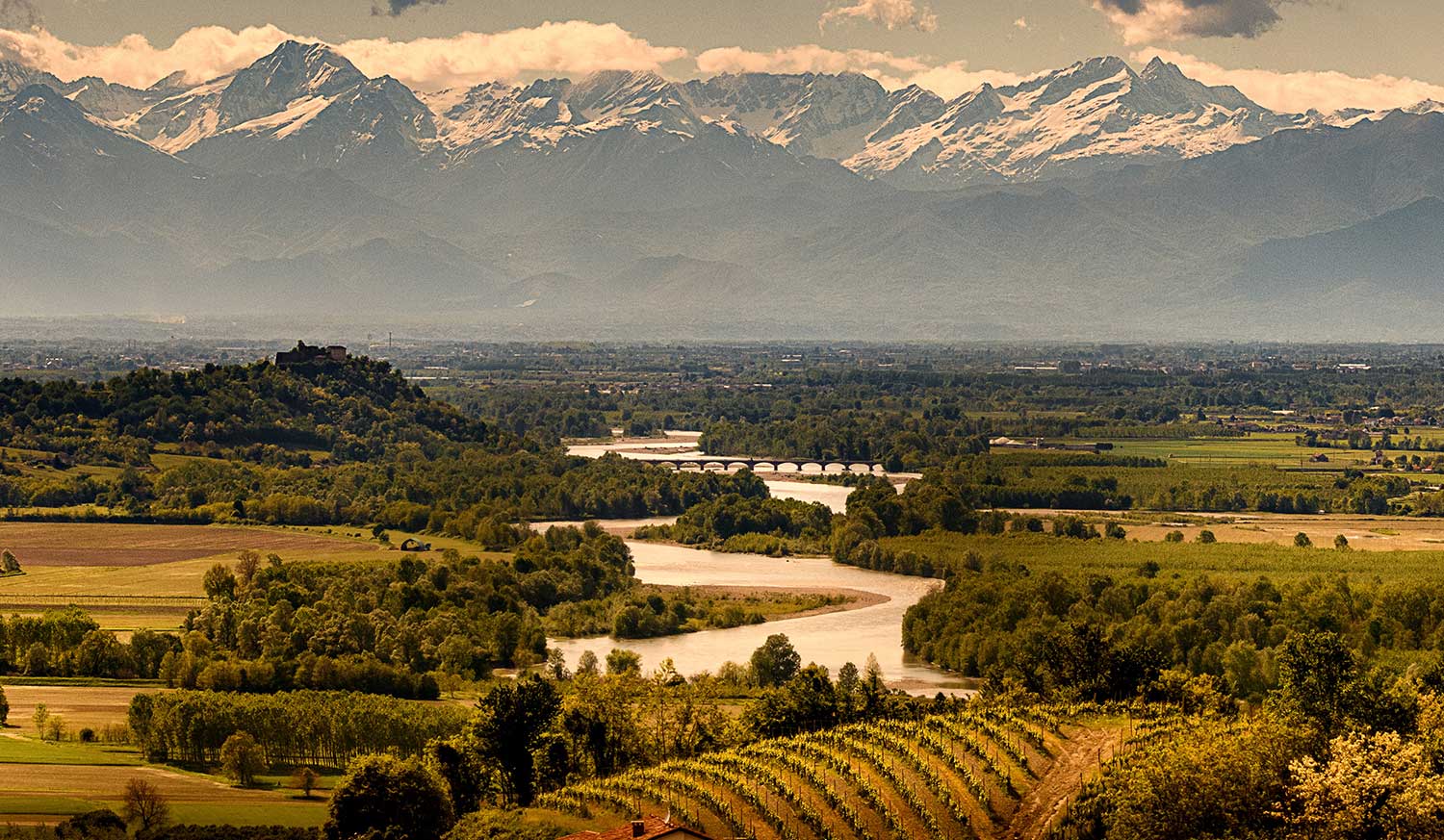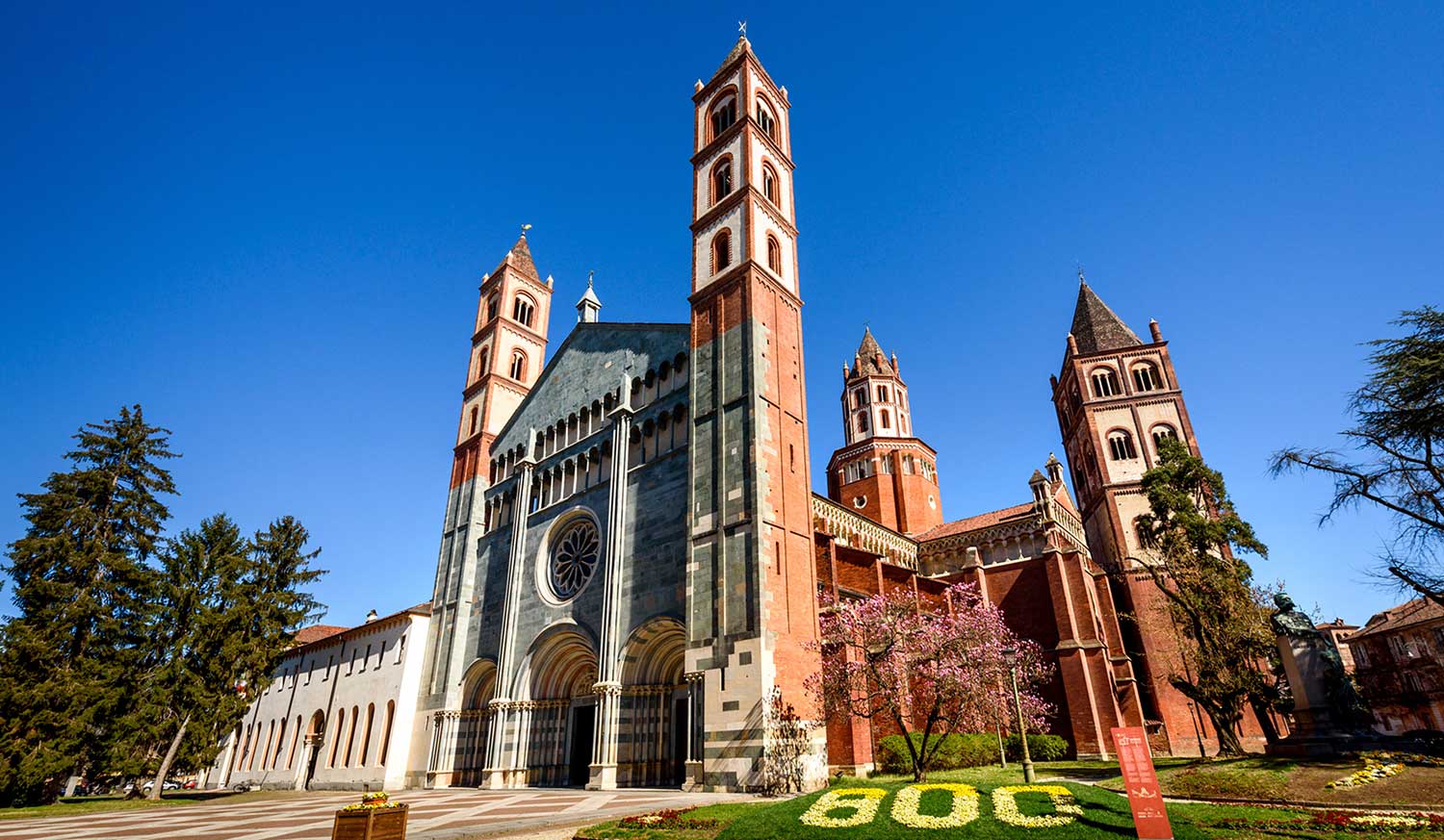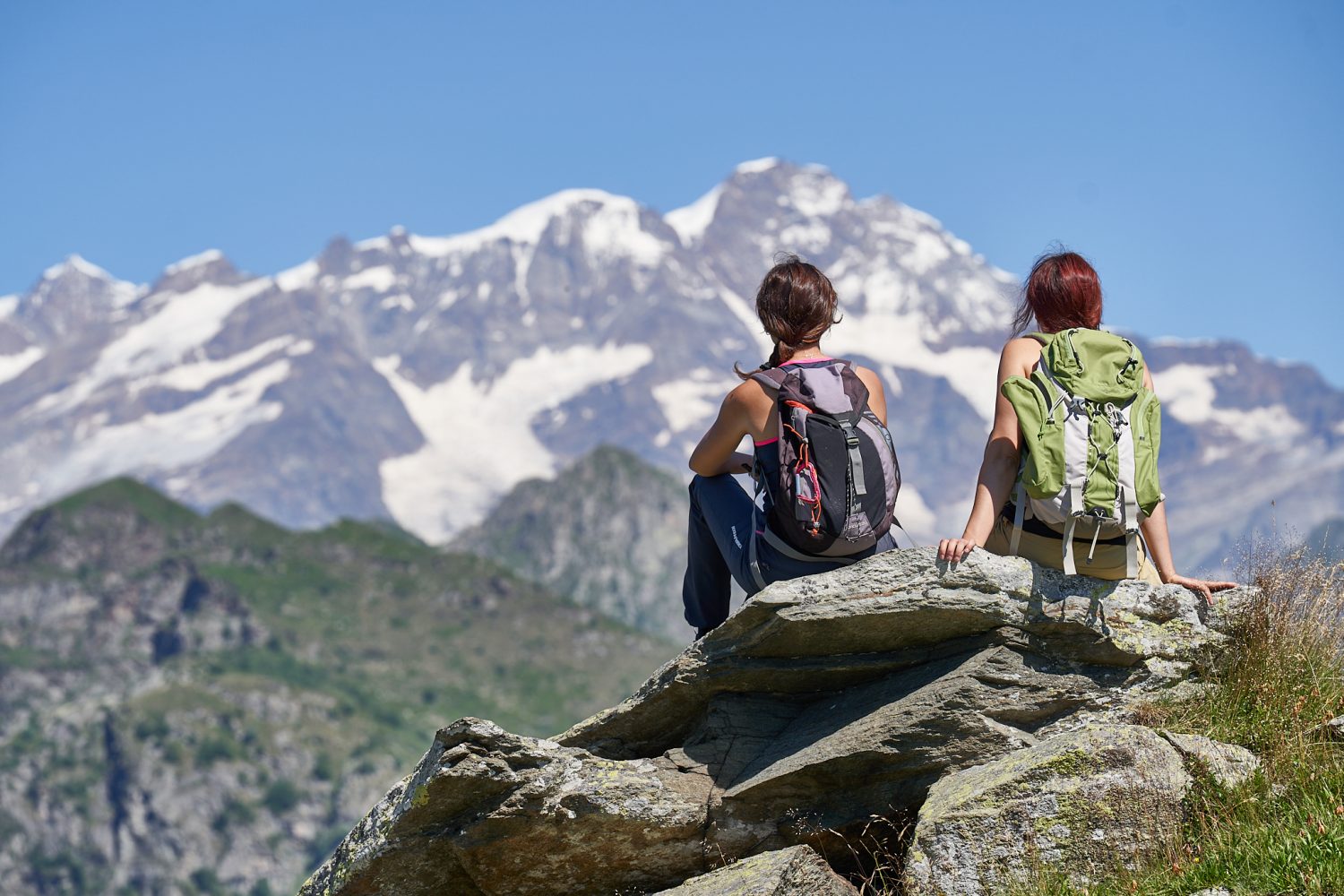
A day in Vercelli
A JOURNEY THROUGH ART AND CULTURE
IN EUROPE’S RICE CAPITAL
One-day itinerary to explore Vercelli, one of the most fascinating cities in Piedmont, rich in treasures and artistic masterpieces surrounded by a unique landscape.
ABBEY OF ST. ANDREW, MAJOR HOSPITAL AND THE ARCA EXHIBITION CENTRE
The city tour can only start from the symbol of the city of Vercelli, the Abbey of St. Andrew. Built between 1219 and 1227 at the behest of Cardinal Guala Bicchieri, it is an amazing example of a fusion between the Lombard-Emilian Romanesque style and transalpine Gothic architecture. Inside, it houses one of the most beautiful chapter houses in Italy, and a charming rectangular cloister with terracotta frames and paintings from the early 16th century.
Opposite the Abbey stands the Dugentesco Hall, founded in 1224 by the cardinal himself. It is the oldest nucleus of the former Ospedale Maggiore, built to accommodate pilgrims travelling along the Via Francigena. The area has undergone a profound transformation in recent years, making it the city’s new cultural hub, given the presence of the University of Eastern Piedmont and the Civic Libraries.
Continuing along Via Galileo Ferraris, located inside the former Church of St. Mark, the ARCA exhibition centre hosts high standard cultural initiatives and exhibitions, such as the Guggenheim collection and the Magna Charta exhibition (2019). On the opposite side of the square is the Church of St. Bernard, seat of the diocesan sanctuary of Maria Salute degli Infermi, an important centre of devotion.


ST. CHRISTOPHER, PIAZZA CAVOUR AND THE ANCIENT BROLETTO
The itinerary continues to the Church of St. Christopher, also known as the “Sistine Chapel of Vercelli”. Built in the first half of the 16th century, it presents impressive masterpieces by Gaudenzio Ferrari, including the altarpiece of the Madonna of Orange Trees.
From here you reach Cavour Square, formerly known as Piazza Maggiore, located in the heart of the historic city centre, a meeting place for all the people of Vercelli and the city’s most important square. Dominated by the mighty Angel Tower, it is characterised by medieval pointed arch arcades. In the centre of the square stands the monument dedicated to Camillo Benso Count of Cavour, built in 1854.
A few steps away from Cavour Square is the ancient Broletto, the original seat of the municipality from 1200 to 1800, and home to another square much loved by the people of Vercelli: Palazzo Vecchio Square, or “Piazza dei Pesci” (Fish Square) to recall the fish market once held here. The square is dominated by the Civic Tower, the oldest tower in Vercelli, which confirms the appellation of turreted city.


VIA FOA, CORSO LIBERTÀ, AND THE BORGOGNA MUSEUM
Continuing along Via Foa, you come to the Synagogue, the first in Italy to be built in an autonomous building between 1875 and 1878. Continuing along the street you find the Church of St. Julian, embellished with a work by Lanino, and Casa Centoris, famous for the elegance of its courtyard, whose Bramante-style façade has recently been restored. The adjacent Volto dei Centori is a gem. This narrow, photogenic roofed alley leads to Corso Libertà, the city’s best known thoroughfare.
Further on, in the namesake square, stands Palazzo Tizzoni, the historic home of one of the most important Ghibelline families of medieval Vercelli. It is particularly interesting for the frescoes decorating the entrance hall, the only known secular work to date painted by the artist Guglielmo Caccia, known as “Il Moncalvo”. Both structures can only be visited during special artistic heritage days.
Continuing along Corso Libertà, on the right, in the former complex of St. Clair’s monastery, stands the Archaeological Civic Museum (MAC), which displays artefacts from the ancient Roman city of Vercellae. Turn left for the Borgogna Museum, a beautiful house-museum, which, in addition to its rich collection of paintings, furnishings and art objects, houses the picture gallery of Vercelli’s Renaissance paintings collected since the 19th century by the Institute of Fine Arts.


VISCONTI CASTLE, LEONE MUSEUM AND CIVIC THEATRE
Further on, through St. Francis Square, you reach the Visconti Castle. Built with a quadrangular floor plan from 1290 onwards, it became first a Savoy residence, then a prison and, from 1838 to the present day, the seat of the Law Court and, therefore, cannot be visited.
Walking along Via Carducci, with a short deviation onto Via Verdi, a characteristic cobbled street full of craft workshops, you can visit the Leone Museum. Housed in the Renaissance Casa Alciati and the Baroque Palazzo Langosco, it exhibits Palaeolithic, Neolithic and Bronze and Iron Age artefacts, and has a Roman room with some of the oldest evidence of Vercelli’s history.
At the end of Via Verdi you will come across the Civic Theatre, built in 1812-14 and inaugurated on 4 July 1815 with the opera in music “Evelina”. To date the Civic Theatre hosts a wide range of theatrical reviews.


ST. EUSEBIUS CATHEDRAL AND THE CATHEDRAL TREASURE MUSEUM
Walking down Via Monte di Pietà, you reach Angennes Square, packed with important historical buildings, starting with the Archbishop’s Palace, continuing with the Museum of the Cathedral Treasury, the Cathedral of St. Eusebius and the Archbishop’s Seminary.
The Archbishop’s Palace, a Renaissance building of great historical value, houses on the ground floor the Museum of the Cathedral Treasury, which exhibits precious reliquaries, expertly crafted items in gold, liturgical furnishings and the “Vercelli Book”, a famous codex written on parchment in the Anglo-Saxon language dating back to the 10th century.
St. Eusebius Cathedral, built as a cemetery basilica from the 5th century onwards, and rebuilt in 1570, has an imposing Baroque façade. The Archbishop’s Seminary was established in 1572. The oldest part is designed by Filippo Juvarra. It is home to the Agnesian and Diocesan Library.


Abbazia di S. Andrea
Costruita fra il 1219 ed il 1227 per volere del cardinale Guala Bicchieri, la Basilica rappresenta uno splendido esempio di fusione tra lo stile romanico lombardo – emiliano e l’architettura gotica d’oltralpe. Al suo interno, è ospitata una delle più belle sale capitolari d’Italia, e un incantevole chiostro rettangolare con cornici in cotto e pitture dell’inizio del ‘500.
Salone dugentesco e Antico Ospedale Maggiore
Antistante la Basilica si trova il Salone Dugentesco, fondato nel 1224 dallo stesso cardinale, che costituisce il nucleo più antico dell’ ex Ospedale Maggiore, sorto per accogliere e prendersi cura dei pellegrini e viandanti che percorrevano la Via Francigena. Pregevoli il portico ad arcate e la sala interna affrescata suddivisa in tre navate, spesso aperti e visitabili in occasioni di mostre ed eventi.
Polo espositivo Arca
Ubicato all’interno della chiesa di San Marco, il polo espositivo ARCA ospita iniziative culturali e mostre di alto livello.
Chiesa di San Bernardo
Sul lato opposto della piazza è situata la chiesa di San Bernardo, sede del santuario diocesano di Maria Salute degli Infermi, importante centro di devozione.
Chiesa di San Paolo
la chiesa di San Paolo, che ospita due tele del Lanino
Chiesa di San Cristoforo
lachiesa di San Cristoforo, edificata nella prima metà del 1500, che vanta splendidi capolavori di Gaudenzio Ferrari tra cui spicca la pala con il titolo diMadonna degli Aranci,e la chiesa di San Lorenzo, una delle più antiche parrocchie di Vercelli
Piazza Cavour
Da qui, passando per via Crispi, si raggiunge Piazza Cavour, un tempo conosciuta come Piazza Maggiore, sita nel cuore del centro storico, luogo d’incontro per tutti i vercellesi nonchè piazza più importante della città. Dominata dalla poderosa Torre dell’Angelo, è caratterizzata dai portici ad arco acuto di epoca medievale. Al centro della piazza sorge il monumento dedicato a Camillo Benso conte di Cavour, realizzato nel 1854.
Antico Broletto
A pochi passi da Piazza Cavour si trova l’antico Broletto, originaria sede del Comune dal 1200 al 1800, sede di un’altra piazza molto amata dai vercellesi: Piazza Palazzo Vecchio, o in gergo “Piazza dei Pesci” a ricordare il mercato ittico che una volta qui si teneva. Domina la piazza la Torre Civica, la più antica di Vercelli, a confermare particolarmente calzante l’appellativo di città turrita.
Sinagoga
la Sinagoga, prima in Italia ad essere costruita in un edificio autonomo, eretta tra il 1875 e il 1878.
Chiesa di San Giuliano
di San Giuliano, arricchita da un’ opera del Lanino,
11
Corso libertà
Casa Centoris
Casa Centoris, famosa per l’eleganza del suo cortile interno, la cui facciata si stile bramantesco è stata recentemente restaurata
Palazzo Tizzoni
Palazzo Tizzoni, storica dimora di una delle più importanti famiglie ghibelline della Vercelli medievale. Di particolare interesse sono gli affreschi ch decorano il Salone all’ingresso, unica opera profana ad ora conosciuta dipinta dall’artista Guglielmo Caccia, detto “Il Moncalvo”. Entrambe le strutture sono visitabili solo durante particolari giornate di valorizzazione del patrimonio artistico.
Museo Archeologico
nell’ex complesso del monastero di Santa Chiara, troviamo il Museo Archeologico, MAC nel quale sono esposti reperti provenienti dall’antica città romana di Vercellae. Sv
Museo Borgogna
il Museo Borgogna, seconda pinacoteca del Piemonte. Oltre alla ricca collezione di quadri, arredi e oggetti d’arte, ospita la quadreria di pittura rinascimentale vercellese raccolta fin dal XIX secolo dall’Istituto di Belle Arti.
Chiesa di Sant’Agnese
hiesa goticaSant’Agnese in San Francesco
Castello visconteo
Castello Visconteo, a pianta quadrangolare, edificato a partire dal 1290 e divenuto prima residenza sabauda, poi carcere e, a partire dal 1838 e fino ai giorni nostri, sede del Tribunale e pertanto non visitabile
Museo Leone
l Museo Leone. Ospitato nella rinascimentale Casa Alciati, espone reperti del Paleolitico, Neolitico ed Età del Bronzo e del ferro e una sala romana che ospita tra le più antiche attestazioni della storia di Vercelli.
Teatro Civico
Alla termine di via Verdi ci si imbatte nel Teatro Civico, costruito nel 1812-14 ed inaugurato il 4 luglio 1815 con l’opera in musica “Evelina”. Ancora oggi, il Teatro Civico, ospita rassegne teatrali sempre diverse. Percorrendo via Monte di Pietà si raggiunge piazza D’Angennes, ricca di edifici storici ed importanti a partire dal Palazzo Arcivescovile, proseguendo con il Museo del Tesoro del Duomo, la Cattedrale di Sant’Eusebioe il Seminario Arcivescovile.
Museo del Tesoro del Duomo
Il Palazzo Arcivescovile, edificio rinascimentale di grande valore storico, ospita al pianoterra il Museo del Tesoro del Duomo che raccoglie preziosi reliquari, opere di oreficeria, arredi liturgici e il “Vercelli Book”, famoso codice scritto su pergamena in lingua anglosassone risalente al X secolo. La Cattedrale presenta un’imponente facciata barocca e fu eretta come basilica cimiteriale a partire dal V secolo, poi ricostruita nel 1570. Il Seminario Arcivescovile fu fondato nel 1572. La parte più antica fu progettata da Filippo Juvarra. Qui ha sede la Biblioteca Agnesiana e Diocesana.
Cattedrale di Sant’Eusebio
La Cattedrale presenta un’imponente facciata barocca e fu eretta come basilica cimiteriale a partire dal V secolo, poi ricostruita nel 1570.
Seminario arcivescovile
Il Seminario Arcivescovile fu fondato nel 1572. La parte più antica fu progettata da Filippo Juvarra. Qui ha sede la Biblioteca Agnesiana e Diocesana.
Parco Kennedy
Con una veloce passeggiata attraverso i giardini di Parco Kennedy all’ombra dei suoi possenti alberi, si giunge nuovamente nei pressi della stazione ferroviaria da dove il nostro tour era cominciato.
HOW TO GET TO VERCELLI
BY HIGHWAY
From Milan: A4 Milan-Turin A26 junction at Biandrate, direction Alessandria. Exit at Vercelli East and follow the 143 regional road.
From Torino: A24 Turin- Milan junction A26 at Santhià, direction Alessandria. Exit at Vercelli West, and follow the 143 regional road.
BY TRAIN
Vercelli is located on the Milan-Turin railway line.
BY BUS
Daily bus services link Vercelli with Biella, Varallo, Casale Monf.to and Alagna Valsesia. Discover how to get to Vercelli.

Plan your holiday
Where to eat, where to sleep, how to get around: plan your trip to Valsesia and Vercelli!




































